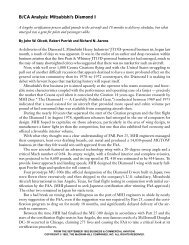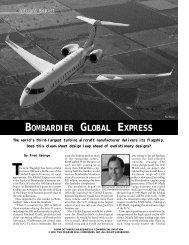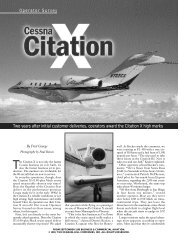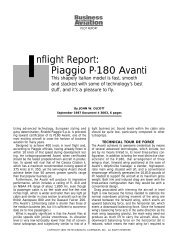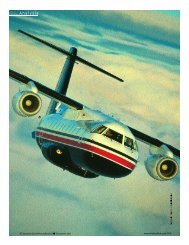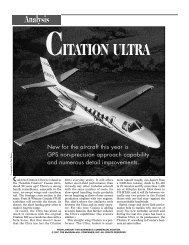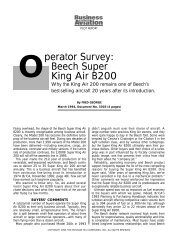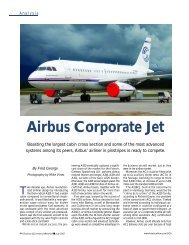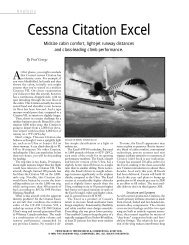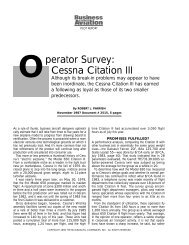B/CA Analysis: Cessna Citation V
B/CA Analysis: Cessna Citation V
B/CA Analysis: Cessna Citation V
- No tags were found...
You also want an ePaper? Increase the reach of your titles
YUMPU automatically turns print PDFs into web optimized ePapers that Google loves.
P ilotReportOnce at altitude, we made a quick check of bookspeeds and fuel flows. We were showing about 390KTAS burning 970 pph total. (See accompanying specificrange data.)Our maneuvering trials at FL 430 were interesting.First, the airplane is quite agile in normal bankingmaneuvers. (Our indicated airspeed was about 220knots.)A 45-degree banked steep turn produced a little tailbangingas the airplane loaded up to about 1.5 g’s.<strong>Cessna</strong> aerodynamic engineers told us later that <strong>Citation</strong>sfinally are reaching altitude and weight combinationsthat can make buffet boundaries at least a passingconsideration for some operations, as it is with mostjets. The flight test engineers assured us there’s a verycomfortable margin between onset of mild tail bangand the actual stall. We also should point out that the<strong>Citation</strong> S/II was the first <strong>Citation</strong> to have buffet boundarytables in its flight manual, although our guess is thatmost <strong>Citation</strong> S/II pilots haven’t had reason to look atthose pages since initial training. Of course, the sweptwing,high-performance <strong>Citation</strong> III has such a pageand appropriate operational limitations.Now that the <strong>Citation</strong> V is approved for operations atFL 450, certification rules dictate it needs to be able toget down quickly- more quickly than the gear-up, spoilers-outdescent procedure used on earlier <strong>Citation</strong>s.Indeed, the emergency descent procedure for the <strong>Citation</strong>V involves throwing out the spoilers (at any speed)and then the gear at or below the new V, E of 250knots, then aiming the nose toward the ground (about25 degrees nose-down) and holding 0.755 Mach or250 knots. (The only modification to get the gear speedup to 250 knots was to add a bit more structure in thesmall keystone-shaped panel of the nosegear door.)The descent in this configuration is an impressive ride.We traveled from FL 430 to 16,000 feet in this attitudewith a descent rate well over 6,000 fpm. Again, theairplane is rock-stable with no tendency to slip awayfrom you or accelerate away from trim speed.We used a block of airspace between 14,000 and16,000 feet to look at low-speed handling, stalls,trim/configuration changes and engine-out maneuvering.Once again, the <strong>Citation</strong> genes showed, althoughthere is no question that the <strong>Citation</strong> V is more than aclone of its predecessors.Similarities and differences can be seen in stalls. Wetried several. In a clean, power-off stall the airplaneretains full aileron control right through the break-typical<strong>Citation</strong> all the way. However, the break itself and theroll-off were a little more abrupt than we rememberedfrom similar trials in the <strong>Citation</strong> II, although aileronpower is well within certification requirements. Later,we checked with the flight test engineers on this pointand they agreed: The <strong>Citation</strong> V can be a bit moreaggressive than earlier models in the stall, but againkeep in mind we’re comparing <strong>Citation</strong> with <strong>Citation</strong>.The break came at 88 KIAS when clean and 76 KIASin landing configuration.As a class, all <strong>Citation</strong>s have remarkably good lowspeedhandling characteristics and generally docilestall traits. The <strong>Citation</strong> V will do nothing to besmirchthe family reputation .A STEADY PLATFORM EASESWORKLOADB/<strong>CA</strong> editors often have expressed our belief that anairplane’s handling characteristics in approach maneuveringconfiguration arguably are the single mostimportant measure of aircraft pilot-friendliness and, ultimately,safety.Our theory is based on the fact that the approachphase requires the pilot to direct a good deal of attentionaway from basic aircraft handling. The list of attention-grabbingtasks includes altitude awareness,traffic-watching, navigation, communications, weatherand checklists.To the extent that any airplane’s handling characteristicsrequire an extra amount of crew attention, the otherapproach-related items must, of necessity, receive less.The results, we believe, can be seen in the accidentstatistics.Anyway, the <strong>Citation</strong> V, like its stable-mates, is asuperb instrument platform. We trimmed the airplane to150 knots-a typical initial approach maneuveringspeed-and then, keeping hands off the wheel, reconfiguredthe flaps, gear and spoilers.The airplane’s reaction to all these perturbationsrequired little if any pilot compensation. For example,the flaps are interconnected with the trim. Moving theflap lever from zero to the 15-degree approach settingat 150 knots causes a very slow deceleration while thenose settles a degree or two below the no-flap trim attitude.Gear extension and spoiler deployment both createonly minor trim changes.Book VREF ranges from 106 knots at max landingweight of 15,200 pounds to 88 knots at or below10,500. We made three approaches and landings toa full stop including one simulated engine-out arrivalwith asymmetric thrust reverse after touchdown. Weused a VREF Of 92 knots at our weight of just under11,500 pounds.The <strong>Citation</strong> V’s inherent stability in approach configuration(full flaps and gear with a fuel flow of about500 pph per side) and Honeywell’s EFIS single-cuecommand display combine to take most of the work outof the approach management task.Typically, the approach is flown at VREF+10 andCOPYRIGHT 1995 THE MCGRAW-HILL COMPANIES ALL RIGHTS RESERVED



